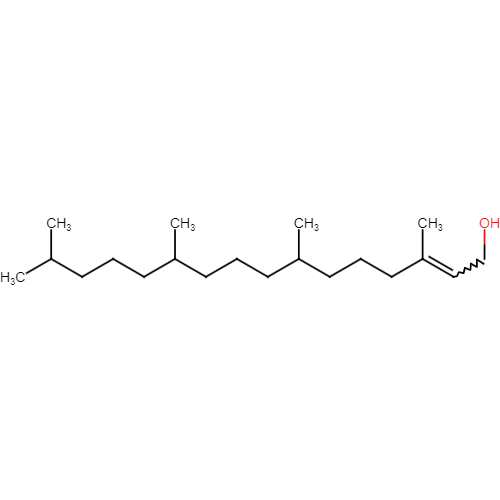3,7,11,15-Tetramethyl-2 hexadecene-1-ol
| Compound Structure: |

|
||||||||||||||||||||||||||||||||||||||||||||
|---|---|---|---|---|---|---|---|---|---|---|---|---|---|---|---|---|---|---|---|---|---|---|---|---|---|---|---|---|---|---|---|---|---|---|---|---|---|---|---|---|---|---|---|---|---|
| Synonyms: | Phytol;3,7,11,15-TETRAMETHYL-2-HEXADECEN-1-OL;7541-49-3;3,7,11,15-Tetramethylhexadec-2-en-1-ol;2-Hexadecen-1-ol, 3,7,11,15-tetramethyl-;(E)-3,7,11,15-tetramethylhexadec-2-en-1-ol | ||||||||||||||||||||||||||||||||||||||||||||
| Compound ID: | NMPC-325 | ||||||||||||||||||||||||||||||||||||||||||||
| PubChem ID: | |||||||||||||||||||||||||||||||||||||||||||||
| Molecular Formula: | C20H40O | ||||||||||||||||||||||||||||||||||||||||||||
| Canonical SMILES: | CC(C)CCCC(C)CCCC(C)CCCC(=CCO)C | ||||||||||||||||||||||||||||||||||||||||||||
| InChIKey: | BOTWFXYSPFMFNR-HMMYKYKNSA-N | ||||||||||||||||||||||||||||||||||||||||||||
| About the compound: | 3,7,11,15-Tetramethyl-2-hexadecen-1-OL is a naturally occurring compound present in various organisms such as Echinophora tournefortii and Juniperus. Phytol is an acyclic diterpene alcohol and is notably a component of chlorophyll. It serves as a common precursor in the production of synthetic variants of both vitamin E and vitamin K1. Additionally, it has been demonstrated that phytol can influence gene expression in cells through its interaction with transcription factors like PPAR-alpha and retinoid X receptor (RXR). GHS Hazard Statements • H315 (100%): Causes skin irritation [Warning Skin corrosion/irritation] • H400 (95.12%): Very toxic to aquatic life [Warning Hazardous to the aquatic environment, acute hazard] • H410 (97.7%): Very toxic to aquatic life with long lasting effects [Warning Hazardous to the aquatic environment, long-term hazard] |
||||||||||||||||||||||||||||||||||||||||||||
| Properties: |
Chemical
and Physical Properties
Source: PubChem |
||||||||||||||||||||||||||||||||||||||||||||
| Source Species: |
Moringa oleifera Justicia insularis |